Woodland garden ideas – simple ways to create a serene, shaded spot
Transform your space with layered planting and leafy canopies
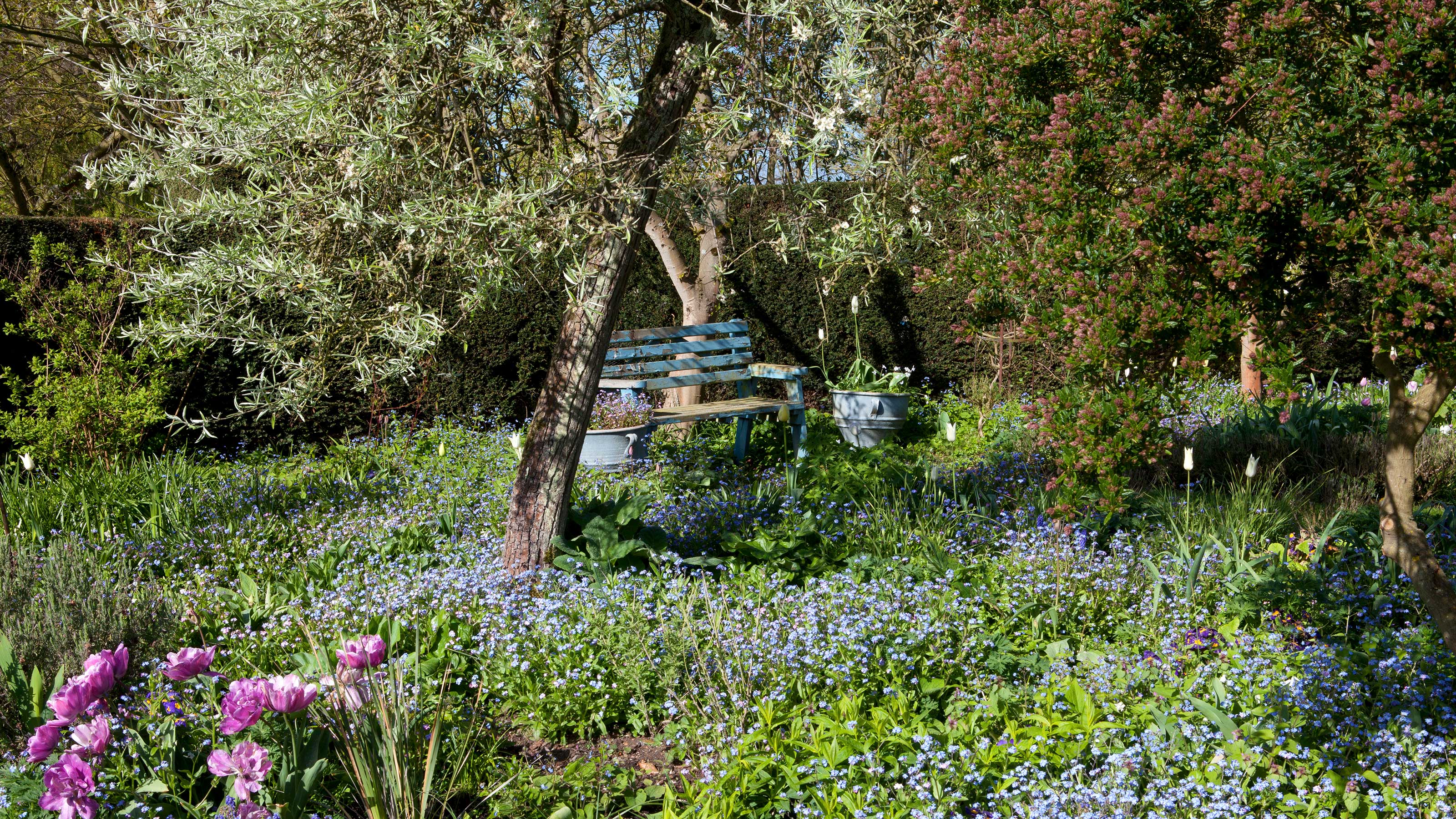
Rachel Crow
There are woodland garden ideas to suit any size of plot outdoors, and immersing yourself in the soft, green foliage of a woodland area can be one of the most relaxing and soothing experiences.
Along with offering shade in summer under a leafy canopy, and a range of different plants, adding a woodland area as part of your garden ideas will encourage an array of wildlife into your garden with habitats, nesting spots and food sources.
Don't think that you need a large garden to introduce these woodland ideas, either – the smallest corner can be transformed with a lush and layered forest feel, so you can include them in your small garden ideas, too.
Woodland areas are ideal for east or north-facing gardens. Only grow plants that suit your soil, as this is not a garden style to mollycoddle plants – they need to do really well without too much intervention and maintenance on your part.
Woodland garden ideas
'Before you start to plant and plan your woodland garden ideas, it is worth considering the feel of the woodland you want to create,' advises Robert Brett, Curator at RHS Hyde Hall.
'Is it to be dense and secluded, or open and tranquil? The characteristic of the woodland comes from creating the layers; the density of the planting and the use of deciduous and evergreen plants to create the required feel.'
1. Plan the area

Identify the area that will work best for your woodland garden ideas and think through how you would like it to look. Is it to be a very separate element among your garden layout ideas or one that seamlessly merges from another zone? Will it be hidden away behind hedges, are you aiming to block out urban views, or link to the surrounding landscape?
Sign up to our newsletter for style inspiration, real homes, project and garden advice and shopping know-how
Committing your design to paper will help clarify your thoughts, and try marking out the boundaries to decide on the size. Visit as many nearby woodlands and gardens with mini-woodlands as you can to hone your ideas. Aim for a combination of shelter and open space with areas of sunshine and shade.
Rosemary Alexander, garden designer, author and principal of The English Gardening School, has created at her home in Sussex the most beautiful woodland area in a domestic setting (image above).
You step down from a Mediterranean-themed terrace to an oasis of layered charm with meandering gravel paths, which seamlessly link from the dry area. 'The backdrop of an existing beech hedge and a few existing trees were important to give height and shelter,' she explains.

Rosemary Alexander is the principal and founder of The English Gardening School, a garden designer and writer, and gives masterclasses around the globe on garden design and planting
2. Layer planting in a woodland garden
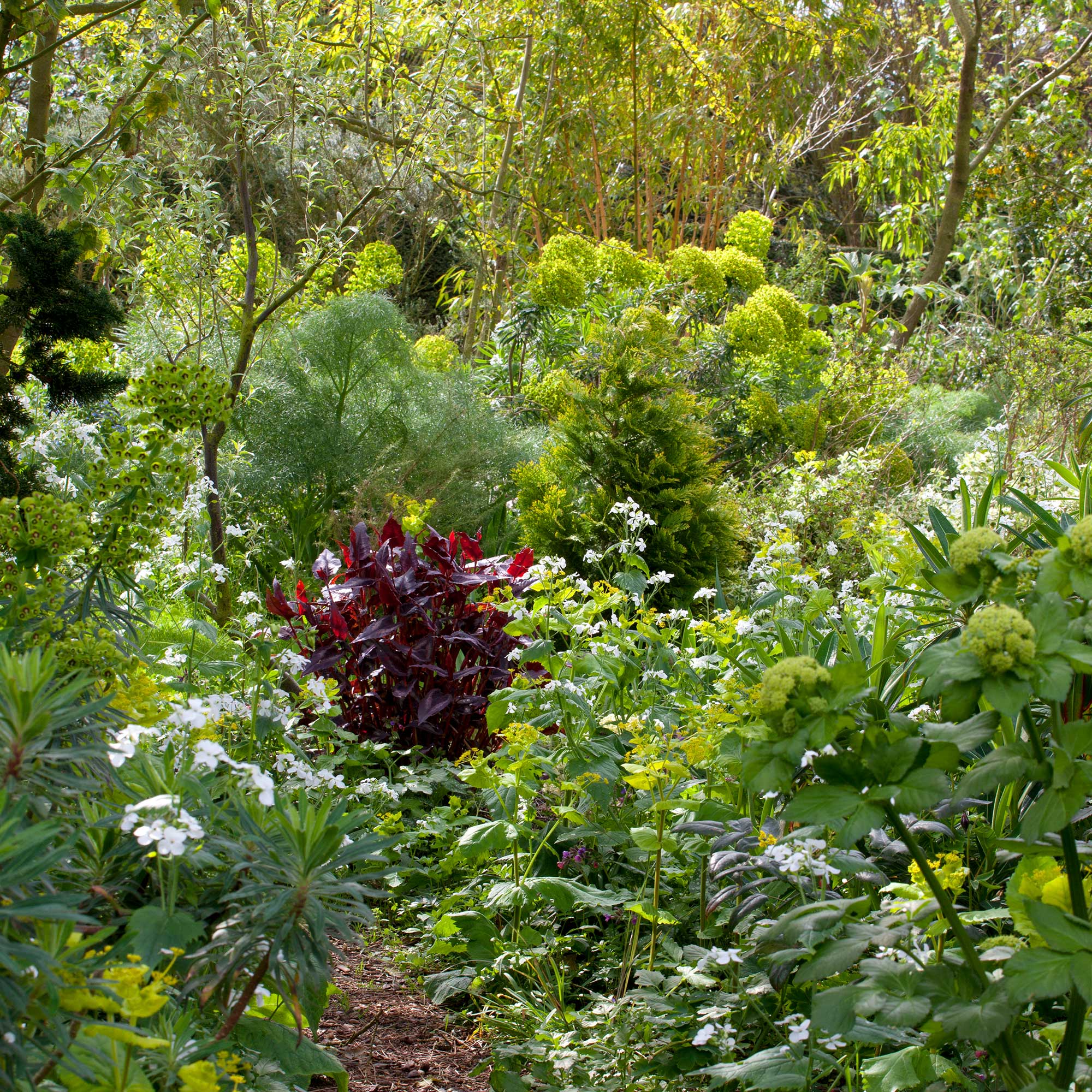
One of the most important woodland garden ideas is to include plant highlights for each season, with interest at different levels, which also adds to its credentials as a sustainable garden idea.
It’s all in the layers; the more natural-looking the layered order, with plants of varied heights, the more biodiverse and successful your woodland garden ideas will be. Many of these can be free plants, created from cuttings, dividing plants or seed saving.
Your aim is to mimic natural woodlands, which are a tapestry of canopies. The levels of a woodland area are:
- A mix of trees of varying sizes and spreads form a light canopy overhead as the top layer;
- A mix of shrubs, including evergreen, deciduous and flowering for the middle layer;
- Perennials, ferns and naturalised bulbs below to form the floor cover, including mat-forming ground cover options;
- Entwining through the layers should be vines and climbers – make sure you know how to plant climbing roses, clematis honeysuckle, ivy, and other climbers.
Planting in order of height, facing the sunlight, ensures all levels of plants will get the amount of light needed for photosynthesis and therefore healthy growth.
3. Create a leafy canopy with trees
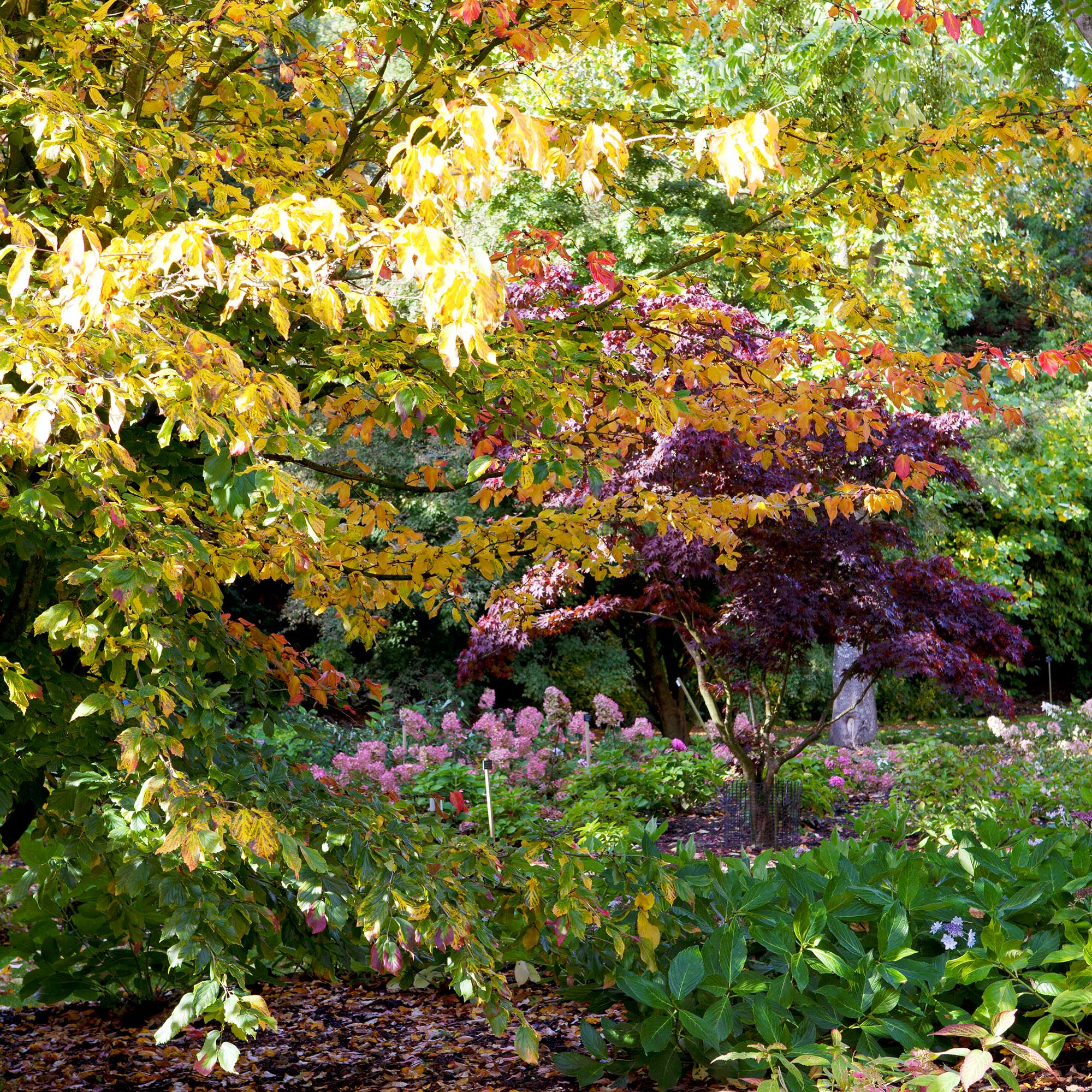
Trees are the backbone of woodland garden ideas. Choose a light or high canopy so that a wide range of plants will grow underneath. Consider both deciduous and evergreen options suited to the soil and climatic conditions, along with those with seasonal interest, such as flowers, berries, fruits, and attractive bark.
For her woodland garden, Rosemary Alexander chose 'a multi-stemmed Betula with three silvery trunks for the main feature in one border, and opposite that I planted Magnolia floribunda ‘Galaxy’ for large pink flowers in spring.'
Broad-leaved native species support greater biodiversity and wildlife species than conifers and introduced plants. Hawthorns, hazel, rowans, holly, crab apples, cherries, acers and birch, are among the attractive options to form a canopy.
How you position trees is also important to the resulting feel of your woodland haven. Cluster planting produces interesting trunk angles and thickness, which intensify the impact.
For a natural look, don’t measure distances between when planting trees – the aim is for a random layout that satisfies the eye and looks as if nature has created the canopy. Until the trees are established it is best to keep the soil around them clear of planting.
4. Offer year round interest
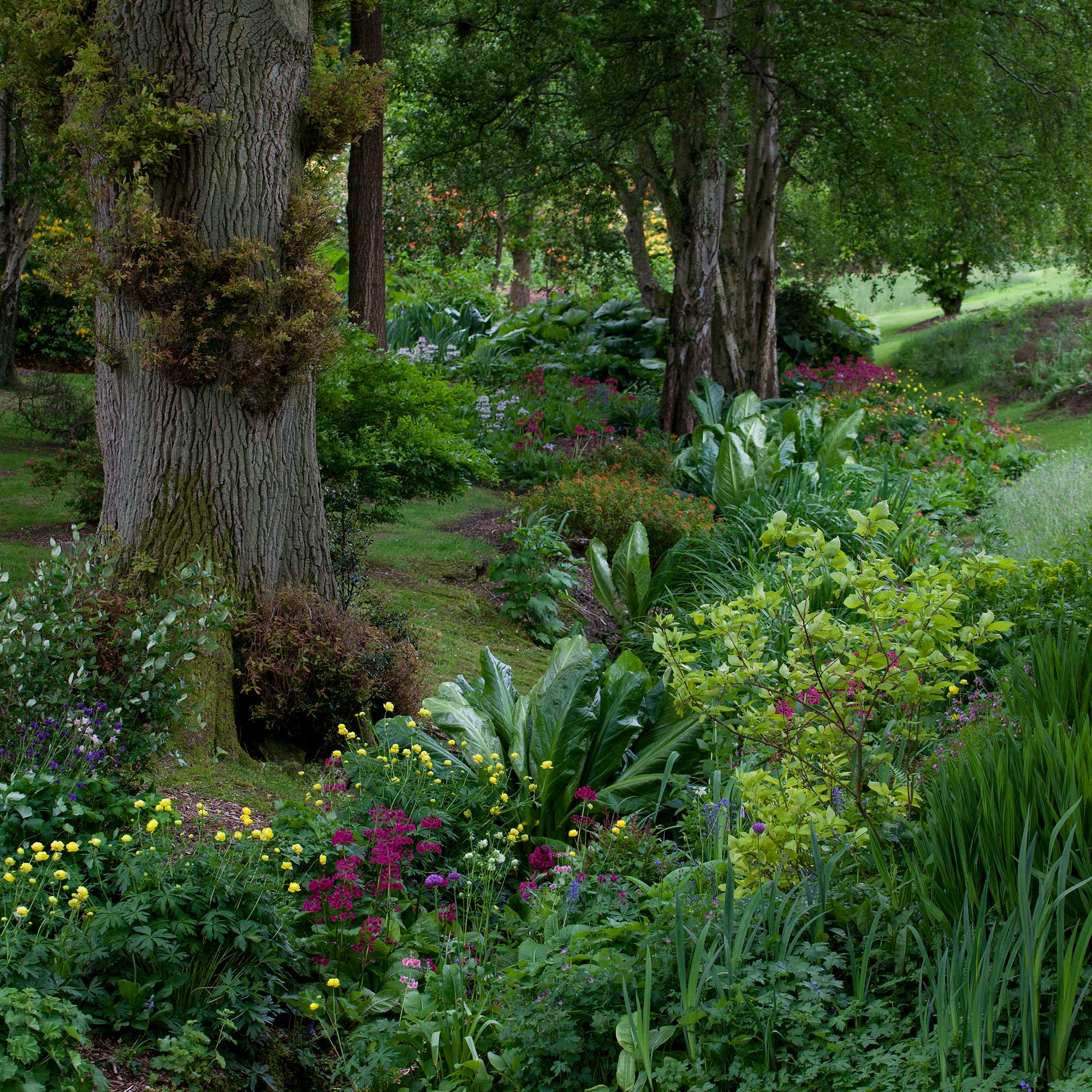
When creating a woodland area, include highlights for each season. This can come from the earliest spring flowering bulbs, trees and shrubs that flower or change leaf colour at different times, the lushness of the closed green canopy in summer, through to autumnal hues and interesting branch and stem shapes in winter.
You may even want your woodland to be a source of forest foods, such as nuts, berries and mushrooms, whether for your own consumption or as a wildlife garden idea. For instance, amelanchier attract pollinators with their nectar-rich star-shaped flowers and birds with their berries.
5. Include variety in the middle layer of planting
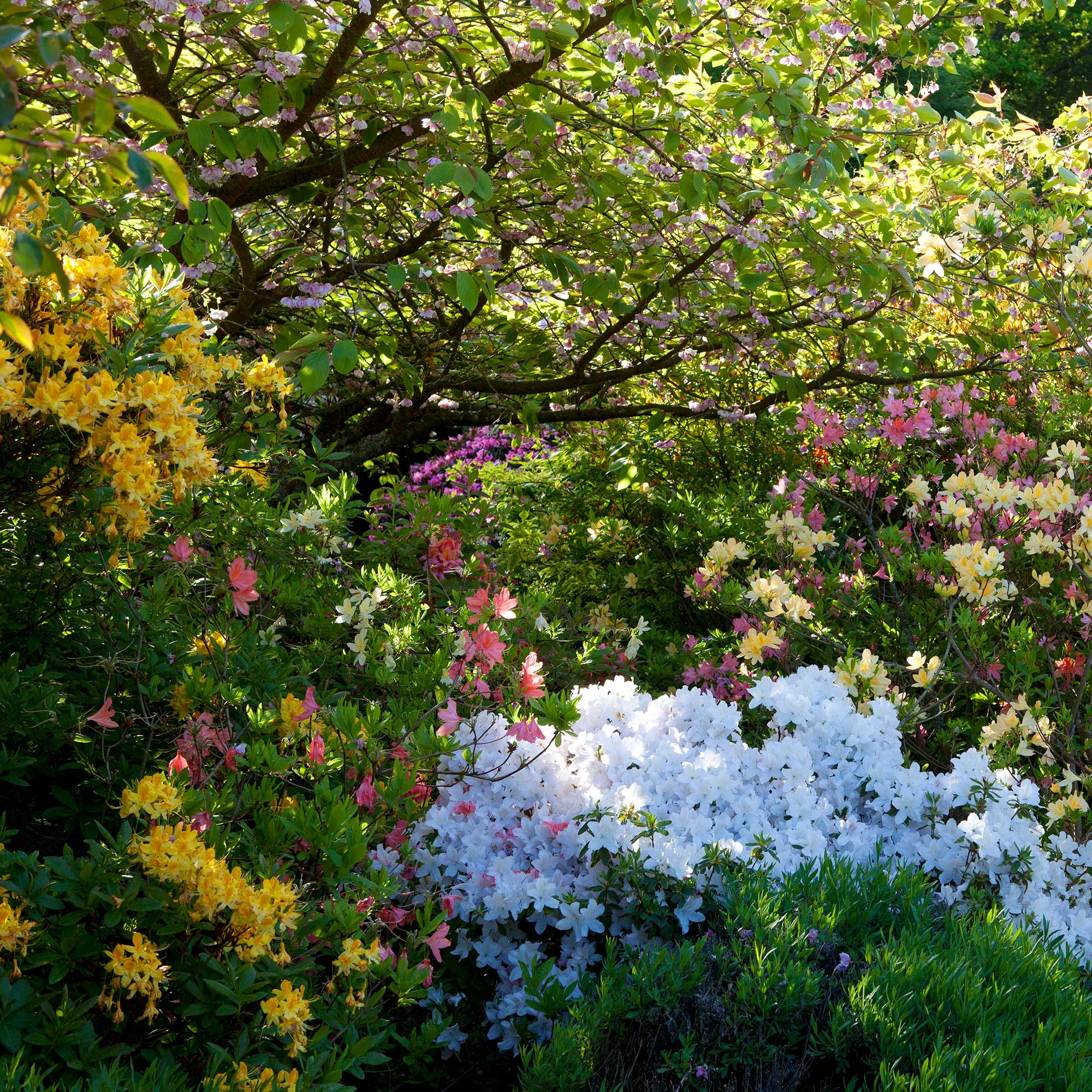
You are aiming for a natural ecosystem in your woodland garden, with shrubs forming the layer beneath the tree canopy.
Research the size and spread of shrubs as well as their soil and climatic needs. Understand how the shade is measured so you choose the best shrubs for the spot:
- Part or semi-shaded refers to a spot with three to six hours of sun;
- Dappled is an area where sunlight filters through the branches of a deciduous tree;
- Deep shade is where there is very heavy shadow with less than two hours of sunlight;
- Dry shade is when large trees take the moisture from the soil.
The soil under trees can be very dry, so add plenty of well-rotted organic matter, such as homemade compost when planting shrubs, and apply a mulch in spring. Plants growing in the shade under trees also have to deal with root competition, so extra care may be needed to get them established, such as watering and feeding in the initial stages.
Select shrubs for their foliage form, texture and colour, using contrasting forms and creating combinations that provide impact to the sense of layering. Medium-sized deciduous shrubs are ideal, such as witch hazels, azaleas, viburnum and philadelphus, along with flowering evergreen rhododendrons and camellias.
Key shrubs Rosemary Alexander has included in her woodland garden are 'Hamamelis ‘Vesna’, H.’Aphrodite’ and Daphne ‘Jacqueline Postill’ chosen for height, scent and early seasonal interest,' she explains.
If you don’t have space for trees, shrubs can also be used as the top canopy in an area of the garden that is shaded, for example by a wall or a neighbour’s tree.
6. Add colour and scent with ground cover plants
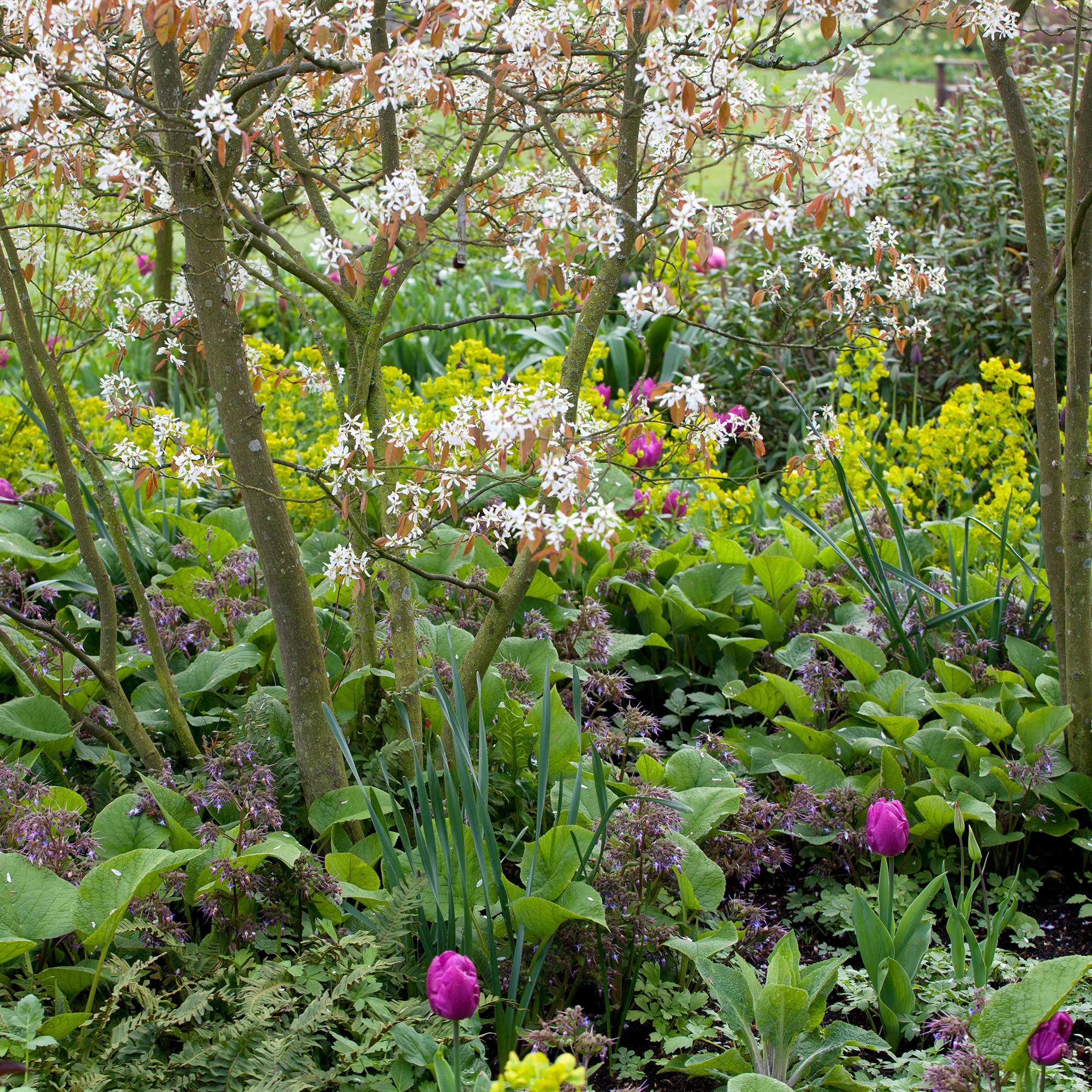
The real stars of the show in woodland garden ideas are at ground level – a tapestry of massed colours, scents and shapes forming a woven carpet.
Just like when you are planting a colourful herbaceous border, for the understorey, try some perennial woodland plants in shades of green, with variegated foliage and a range of flowers. Planting in drifts looks natural – you don't want anything too regimented – and provides impact.
Spring offers some lovely woodland plant options, from early anemones, hellebores and pulmonaria, through primulas, epimediums, tiarella and brunnera to hostas and dicentra.
Along with spring bulbs, look for plants that suit different levels of shade. A community of diverse, compatible shade-tolerant herbaceous plants, ferns, brunnera, heucheras and bulbs will thrive in the dappled sunlight. Include lots of our native woodland plants, such as foxgloves, bluebells and primroses. You can plant right up to the stems of shrubs once they are established.
'For the layered effect I used evergreen ferns in strategic places, interplanting with various hellebores, pulmonaria, and hostas,' says Rosemary Alexander. 'An abundance of existing snowdrops were split up and used for February interest, followed by low growing narcissi and species iris and tulips for spring,’ she adds.
7. Position pathways through the woodland area

Along with the framework of the area, position any elements of hard landscaping, such as garden path ideas, before planting.
‘Natural materials, such as bark, work well for a woodland feel. Paths should meander and perhaps be hidden from views across the woodland, but also have a purpose,’ says Robert Brett from RHS Hyde Hall.
Bark chippings and woodland mulch suppress weeds and retain moisture while also emulating a woodland floor, while garden edging will help to define well-used walkways. Paths edged in small logs can work well or allow the path to run into the planting or have plants pop up in cracks.
Woodland gardens are immersive and feel enclosed, so do create a gently curving journey through the space. Paths can lead to seating and focal points, or be designed to entice you through.
8. Don't forget homes for wildlife
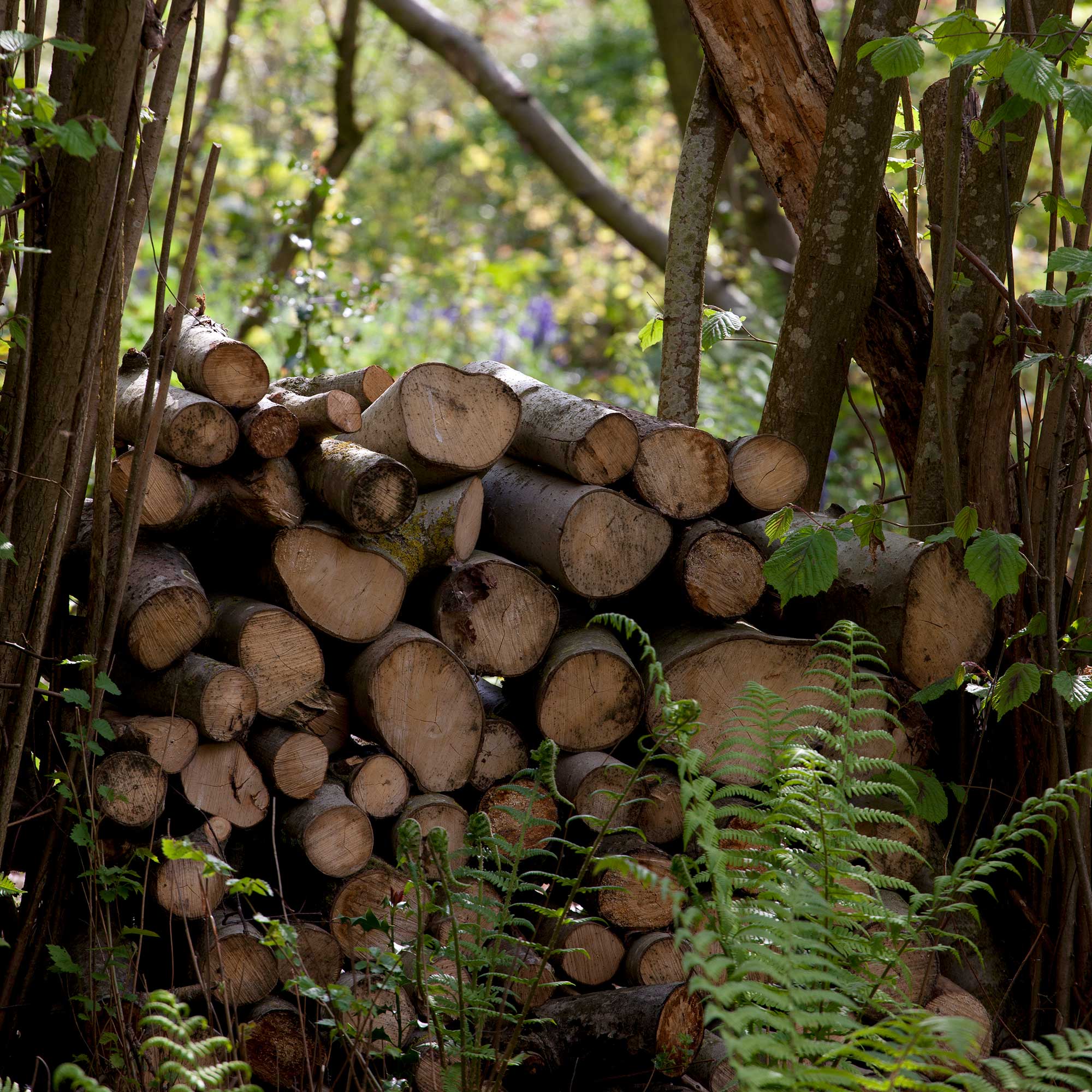
Woodland garden ideas offer a unique chance to encourage a range of shade-seeking wildlife into your garden.
A natural way to encourage more birds into your garden is through planting native fruiting plants, and woodland edges and glades offer a more varied range of habitats.
Although a woodland area still needs management, you are seeking to support and nurture the environment – for instance, thousands of tiny organisms live in leaf litter and decaying wood, which are then food sources.
Include some homes for wildlife, such as bird boxes and wildlife houses, or make a bee hotel. Stack fallen or dead wood in piles as cosy homes for little mammals, beetles and amphibians.
9. Take a seat

Your own private woodland is an opportunity to create an enclosed, hidden oasis where you can sit, enjoy the shade and being immersed in the lush greenery.
Garden seating areas for entertaining work delightfully in clearings or on the edge of the woodland. Hanging garden seats and hammocks slung between trees clad in their summer greenery is a cooling and inviting spot to escape the heat.
Enjoy the therapeutic benefits of the result of your woodland garden ideas made into reality, of just sitting in the shade and listening to the sounds of wildlife, the twitter of birds, buzz of bees, and the breeze rustling through the leaves.
10. Make a woodland feature of existing trees
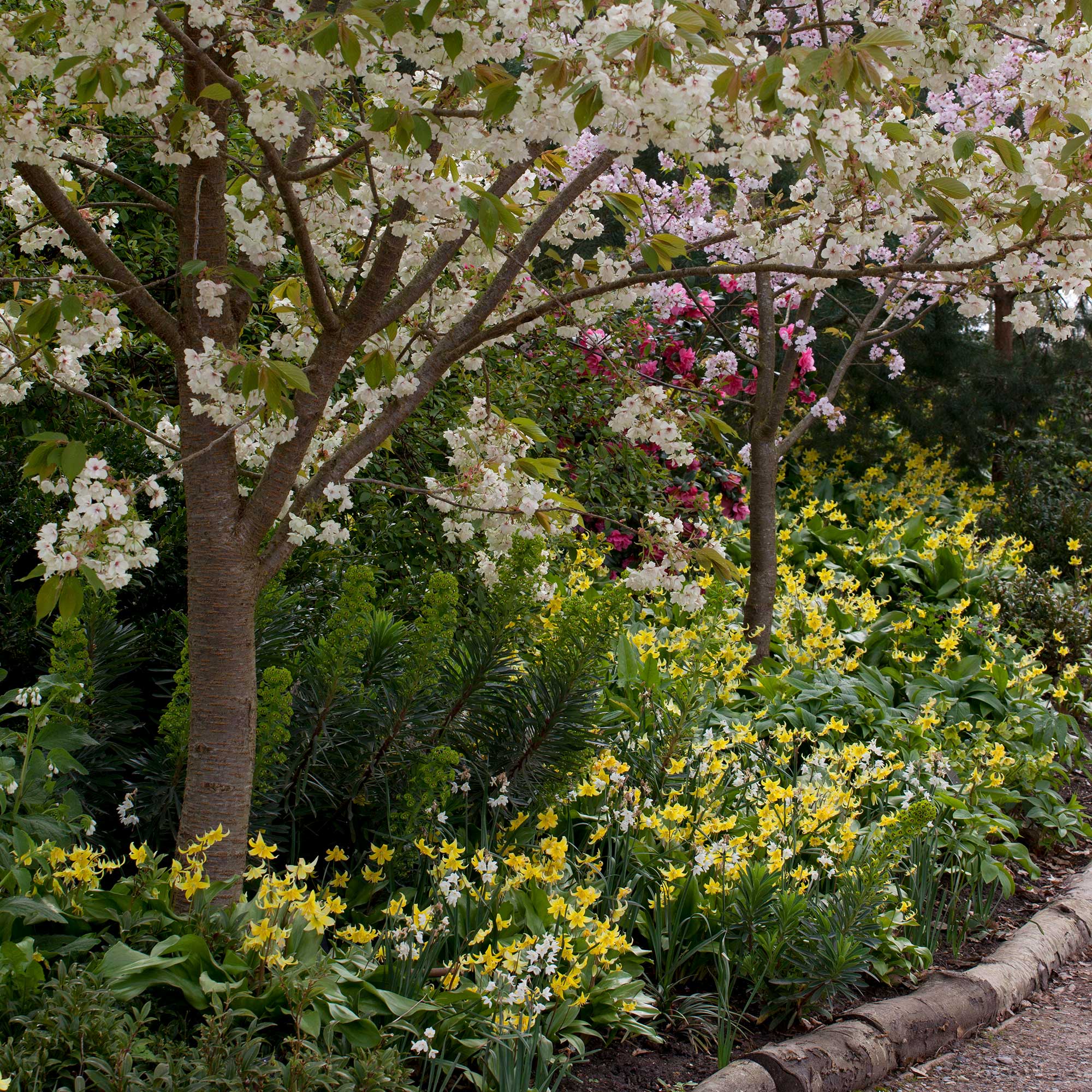
If you are fortunate to have existing mature trees in your garden, you can add some planting underneath to make more of a woodland feature.
By raising the underneath of the canopy – crown lifting – you can let in more light for underplanting. Even adding some potted plants in the shade will add another dimension and can be changed seasonally.
'The first thing to do when planting is to observe what’s already there; look after it and enhance rather than disturbing and changing it wholesale,' says landscape architect Marian Boswall. 'By basing your main palette on the local flora you can be sure of choosing plants that will thrive in local conditions.'
What grows well in a woodland garden?
There are many trees, shrubs and flowers that will grow well within woodland garden ideas.
Tree choices that add seasonal interest include magnolia, which is glorious in spring with its impressive blooms and grows in light shade; amelanchier is a lovely small tree with delicate star-shaped flowers, coppery leaves, berries and a nice form in winter; while prunus, flowering cherry trees, make a spectacular canopy for a woodland area.
In terms of shrubs, rhododendrons, azaleas and camellias are popular choices for woodland garden ideas. Cercis canadensis are large deciduous shrubs and small trees, known for their distinctive heart-shaped leaves, which start purple and turn yellow in autumn before falling. In early spring crimson pea-like flowers also put on a lovely display.
There are myriad choices for ground cover in a woodland garden, including anemones, hellebores, pulmonaria, primulas, epimediums, tiarella, brunnera, hostas, dicentra, honesty, lily-of-the-valley, Welsh poppies, foxgloves, bluebells, euphorbia ... the list goes on.
Does a woodland garden need maintenance?
A woodland garden does require a little bit of maintenance as you want to keep it looking like a garden, not a tangled mess, so management is needed, but with a relaxed, light touch.
Lifting the crown of trees and large shrubs will allow more sunlight to pass through; plants may need thinning out or cutting back while still ensuring a natural look; and keeping woodland garden paths topped up with bark chippings or ensuring the surfaces aren’t slippery will keep it a pleasant and safe environment to enjoy year-round.
Leigh Clapp is a gardening photographer and writer with over 25 years of experience. Leigh’s work appears in magazines, newspapers and books, both in the UK and abroad.
- Rachel CrowSenior Content Editor